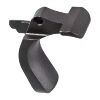aaaaa
Member
I have a Charles Daly Field 1911 in .45 ACP and am looking to change the grip safety as the current one hammers my hand to a black and blue spot if I don't wear a thick glove. Here is the gun (click for internet image).
So, the Wilson drop-in beaver tail grip safety will not work unless I change out the hammer to a commander hammer or bob the hammer, neither of which I want to do. But I found several options below and am wondering if they will fit the gun without major work (or basically at most I would have to file the trigger stop slightly). I also wonder if either of these will solve the problem of my hand being hammered by the grip safety tang (or what do you call it). If neither of those work, would a duck bill (arcs downward more?) grip safety work?
"Pachmayr Beavertail Grip Safety 1911 Series 70 with Spur Hammer"



"1911 Mil Spec - Grip Safety - Standard GI Wide Paddle"

"1911 MIL SPEC - GRIP SAFETY - STANDARD GI RADIUS PADDLE"
"Fusion 1911 Colt non-gunsmith style in Black for Mil Spec style frames. Designed for Mil Spec and A-1 style pistols, and made for people who do not want to mill / alter their frame for a High-Ride beavertail grip safety installation. Made for the 1911 Colt, Springfield, RIA, A1, Mil Spec, and 1911 Mil Spec Clones.. Etc. Standard grip safety fitting of paw may be necessary. These are high quality professional grade."


So, the Wilson drop-in beaver tail grip safety will not work unless I change out the hammer to a commander hammer or bob the hammer, neither of which I want to do. But I found several options below and am wondering if they will fit the gun without major work (or basically at most I would have to file the trigger stop slightly). I also wonder if either of these will solve the problem of my hand being hammered by the grip safety tang (or what do you call it). If neither of those work, would a duck bill (arcs downward more?) grip safety work?
"Pachmayr Beavertail Grip Safety 1911 Series 70 with Spur Hammer"

"1911 Mil Spec - Grip Safety - Standard GI Wide Paddle"

"1911 MIL SPEC - GRIP SAFETY - STANDARD GI RADIUS PADDLE"
"Fusion 1911 Colt non-gunsmith style in Black for Mil Spec style frames. Designed for Mil Spec and A-1 style pistols, and made for people who do not want to mill / alter their frame for a High-Ride beavertail grip safety installation. Made for the 1911 Colt, Springfield, RIA, A1, Mil Spec, and 1911 Mil Spec Clones.. Etc. Standard grip safety fitting of paw may be necessary. These are high quality professional grade."

Last edited:



















